Reassessment of the Columnea latent viroid (CLVd) Taxonomic Classification
Abstract
1. Introduction
2. Materials and Methods
2.1. Characterization of CLVd’s Biological Properties
2.1.1. Plant and Viroid Maintenance
2.1.2. RT-PCR
2.1.3. Symptoms and Severity Rating
2.2. CLVd Genome Sequence Similarity Analysis
2.2.1. CLVd Sequence Analysis
2.2.2. CLVd Symptom Severity and Sequence Similarity Analysis
3. Results
3.1. Characterization of CLVd’s Biological Properties
3.1.1. Phylogenetic Analysis of Four Selected CLVd Isolates
3.1.2. Symptoms and Severity Rating
Tomato cv. Rutgers
Tomato cv. Seeda 50
Tomato cv. Insaf
Bolo Maka
Thai Round Eggplant
Chili Pepper, Bell Pepper and Cucumber
Severity Evaluation of Four CLVd Isolates
3.2. CLVd Genome Sequence Similarity Analysis
3.2.1. CLVd Sequence Analysis
3.2.2. CLVd Symptom Severity and Sequence Similarity Analysis
3.2.3. Conserved Motifs along the CLVd Genome
4. Discussion
5. Conclusions
Author Contributions
Funding
Institutional Review Board Statement
Acknowledgments
Conflicts of Interest
Appendix A
| Isolate Names | Accession No. | Original Hosts | Original Countries | Group No. |
|---|---|---|---|---|
| Chaipayon-1 * | KM214216 | S. lycopersicum | Thailand | Group I |
| Chaipayon-16 | KM214217 | S. lycopersicum | Thailand | Group I |
| Chaipayon-19 | KM214218 | S. lycopersicum | Thailand | Group I |
| Chaipayon-20 | KM214219 | S. lycopersicum | Thailand | Group I |
| CR11-15c1 | JF446931 | S. lycopersicum | Thailand | Group I |
| CR14-9c1 | JF446932 | S. lycopersicum | Thailand | Group I |
| Duenpen 8 | JF742641 | S. lycopersicum | Thailand | Group I |
| GC9 | AM698093 | S. lycopersicum | Thailand | Group I |
| LP1-12c3 | JF446917 | S. lycopersicum | Thailand | Group I |
| LP1-13c1 | JF446918 | S. lycopersicum | Thailand | Group I |
| LP1-14c1 | JF446919 | S. lycopersicum | Thailand | Group I |
| LP1-15c4 * | JF446920 | S. lycopersicum | Thailand | Group I |
| LP1-3c1 | JF446915 | S. lycopersicum | Thailand | Group I |
| LP1-6c5 | JF446916 | S. lycopersicum | Thailand | Group I |
| LP2-1c1 | JF446921 | S. lycopersicum | Thailand | Group I |
| LP2-5c1 | JF446922 | S. lycopersicum | Thailand | Group I |
| LP2-6c1 | JF446923 | S. lycopersicum | Thailand | Group I |
| LP2-7c1 | JF446924 | S. lycopersicum | Thailand | Group I |
| LP2-8c1 | JF446925 | S. lycopersicum | Thailand | Group I |
| LP3-3c2 | JF446926 | S. lycopersicum | Thailand | Group I |
| LP4-7c1 | JF446927 | S. lycopersicum | Thailand | Group I |
| LP4-7c4 | JF446928 | S. lycopersicum | Thailand | Group I |
| LPng16-6c1 | JF446933 | S. lycopersicum | Thailand | Group I |
| LPng19-4c1 | JF446934 | S. lycopersicum | Thailand | Group I |
| MC-M-11 | AM698095 | S. lycopersicum | Thailand | Group I |
| Niruj-14 | KM214221 | S. lycopersicum | Thailand | Group I |
| Niruj-18 | KM214222 | S. lycopersicum | Thailand | Group I |
| Niruj-9 | KM214220 | S. lycopersicum | Thailand | Group I |
| NK10-10c1 | JF446935 | S. lycopersicum | Thailand | Group I |
| NK10-10c3 | JF446936 | S. lycopersicum | Thailand | Group I |
| NK11-14c3 | JF446938 | S. lycopersicum | Thailand | Group I |
| NK11-14c5 | JF446939 | S. lycopersicum | Thailand | Group I |
| NK11-8c4 | JF446937 | S. lycopersicum | Thailand | Group I |
| NK-KUKPS1 | KY235369 | S. lycopersicum | Thailand | Group I |
| PQ-430 | DQ923059 | S. lycopersicum | Thailand | Group I |
| PQ-49 | DQ923058 | S. lycopersicum | Thailand | Group I |
| PQ-720 | DQ923060 | S. lycopersicum | Thailand | Group I |
| PQ-728 | DQ923061 | S. lycopersicum | Thailand | Group I |
| Prayong-13 | KC143293 | S. lycopersicum | Thailand | Group I |
| Prayong-16 | KC143294 | S. lycopersicum | Thailand | Group I |
| Prayong-17 | KC143295 | S. lycopersicum | Thailand | Group I |
| Rutgers 3 | JF742635 | S. lycopersicum | Thailand | Group I |
| Rutgers 9 | JF742636 | S. lycopersicum | Thailand | Group I |
| Sathap-1 | KC143289 | S. lycopersicum | Thailand | Group I |
| Sathap-2 | KC143290 | S. lycopersicum | Thailand | Group I |
| Sathap-21 | KC143292 | S. lycopersicum | Thailand | Group I |
| Sathap-3 | KC143291 | S. lycopersicum | Thailand | Group I |
| Solanum 1 * | JF742632 | S. stramoniifolium | Thailand | Group I |
| Solanum 16 | JF742634 | S. stramoniifolium | Thailand | Group I |
| Solanum 4 | JF742633 | S. stramoniifolium | Thailand | Group I |
| CM10-6c1 | JF446929 | S. lycopersicum | Thailand | Group III |
| CM10-6c2 | JF446930 | S. lycopersicum | Thailand | Group III |
| NC17 | AM698094 | S. lycopersicum | Thailand | Group III |
| PC-2-Pa2 | DQ022677 | S. lycopersicum | Thailand | Group III |
| PC-2-Pa29 | DQ061193 | S. lycopersicum | Thailand | Group III |
| PC-2-Pa54 | DQ061192 | S. lycopersicum | Thailand | Group III |
| clone 1-6 | JQ362419 | S. lycopersicum | Mali | Group IV |
| 93007908 | AY373446 | S. lycopersicum | The Netherlands | Group IV |
| 96009271 | AY365230 | S. lycopersicum | The Netherlands | Group IV |
| 93007481 (14A) * | AY372392 | S. lycopersicum | The Netherlands | Group IV |
| 95001530 | AY372395 | S. lycopersicum | The Netherlands | Group IV |
| 95006685 | AY372396 | S. lycopersicum | The Netherlands | Group IV |
| FERA_160205 | KY810771 | S. lycopersicum | United Kingdom | Group IV |
| 07060402 | FM995506 | S. lycopersicum | France | Group V |
| 07084401 | FM995507 | S. lycopersicum | France | Group V |
| 89001013 | AY367350 | S. lycopersicum | The Netherlands | Group V |
| CLVd-IT | HG916813 | S. lycopersicum | Italy | Group V |
| EF015581 | EF015581 | S. lycopersicum | Portugal | Group V |
| 12 clone 1 | HM043810 | G. purpurascens | Denmark | Group II |
| 12 clone 2 | HM043811 | G. purpurascens | Denmark | Group II |
| 12 clone 3 | HM043812 | G. purpurascens | Denmark | Group II |
| 12 clone 4 | HM043813 | G. purpurascens | Denmark | Group II |
| 13 clone 1 | HM043814 | G. gymnostoma | Denmark | Group II |
| 13 clone 3 | HM043815 | G. gymnostoma | Denmark | Group II |
| 13 clone 4 | HM043816 | G. gymnostoma | Denmark | Group II |
| 14 clone 1 | HM043817 | G. nematanthodes | Denmark | Group II |
| 14 clone 2 | HM043818 | G. nematanthodes | Denmark | Group II |
| 14 clone 3 | HM043819 | G. nematanthodes | Denmark | Group II |
| 14 clone 4 | HM043820 | G. nematanthodes | Denmark | Group II |
| CLVd RNA | X15663 | C. erythrophae | USA | Group II |
| CLVd(Wild-Type) | AY222072 | C. erythropae | USA | Group II |
| complete genome | NC_003538 | C. erythrophae | USA | Group II |
| mRNA | M93686 | N. wettsteinii | Canada | Group II |
| CLVd Isolates | Accession No. | Infectivity on Cucumber | Group No. | References |
|---|---|---|---|---|
| CLVd NC_003538 | NC_003538 | Symptomatic (undescribed) | Group II | [12] |
| CLVd RNA | X15663 | Symptomatic (undescribed) | Group II | [12] |
| CLVd (Wild-Type) | AY222072 | well replicated | Group II | [34] |
| Chaipayon-1 * | KM214216 | no infectivity | Group I | This thesis |
| Solanum 1 * | JF742632 | 50% infectivity but no symptoms | Group I | This thesis |
| LP1-15c4 * | JF446920 | no infectivity | Group I | This thesis |
| 93007481 (14A) * | AY372392 | no infectivity | Group IV | This thesis |
| PC-2-Pa2 | DQ022677 | no infectivity | Group III | [14] |
| PC-2-Pa29 | DQ061193 | no infectivity | Group III | [14] |
| PC-2-Pa54 | DQ061192 | no infectivity | Group III | [14] |
| MC-M-11 | AM698095 | replicated but no symptoms | Group I | [13] |
| NC17 | AM698094 | replicated but no symptoms | Group III | [13] |
| GC9 | AM698093 | replicated but no symptoms | Group I | [13] |
| 93007908 | AY373446 | No results or details given | Group IV | [7] |
| 95006685 | AY372396 | No results or details given | Group IV | [7] |
| 95001530 | AY372395 | No results or details given | Group IV | [7] |
| 89001013 | AY367350 | No results or details given | Group V | [7] |
| 96009271 | AY365230 | No results or details given | Group IV | [7] |
| NK-KUKPS | KY235369 | No results or details given | Group I | [6] |
| Symptoms | Symptom Rating Scales | |||
|---|---|---|---|---|
| 14A | Chaipayon-1 | Solanum-1 | LP1-15c4 | |
| Yellowing of leaves (chlorosis) | 20 | 30 | 50 | 50 |
| Necrotic lesions | 120 | 200 | 200 | 200 |
| Brittle and distorted leaves | 20 | 50 | 50 | 50 |
| Stunted shoots | 80 | 100 | 100 | 100 |
| Stunted stem (height) | 80 | 100 | 100 | 100 |
| Total Score | 3.2 | 4.8 | 5.0 | 5.0 |
| Symptoms | Symptom Rating Scales | |||
|---|---|---|---|---|
| 14A | Chaipayon-1 | Solanum-1 | LP1-15c4 | |
| Yellowing of leaves (chlorosis) | 10 | 40 | 30 | 30 |
| Necrotic lesions | 160 | 200 | 200 | 200 |
| Brittle and distorted leaves | 10 | 20 | 20 | 20 |
| Stunted shoots | 20 | 60 | 100 | 100 |
| Stunted stem (height) | 60 | 60 | 100 | 100 |
| Total Score | 2.6 | 3.8 | 4.5 | 4.5 |
| Symptoms | Symptom Rating Scales | |||
|---|---|---|---|---|
| 14A | Chaipayon-1 | Solanum-1 | LP1-15c4 | |
| Yellowing of leaves (chlorosis) | 10 | 30 | 40 | 40 |
| Necrotic lesions | 40 | 160 | 120 | 120 |
| Brittle and distorted leaves | 20 | 30 | 40 | 40 |
| Stunted shoots | 20 | 40 | 60 | 60 |
| Stunted stem (height) | 20 | 20 | 20 | 20 |
| Total Score | 1.1 | 2.8 | 2.8 | 2.8 |
| Symptoms | Symptom Rating Scales | |||
|---|---|---|---|---|
| 14A | Chaipayon-1 | Solanum-1 | LP1-15c4 | |
| Distorted leaves | 30 | 90 | 150 | 150 |
| Necrotic lesions | 0 | 160 | 160 | 160 |
| Stunted stem (height) | 60 | 90 | 150 | 150 |
| Total Score | 0.9 | 3.4 | 4.6 | 4.6 |
| Symptoms | Symptom Rating Scales | |||
|---|---|---|---|---|
| 14A | Chaipayon-1 | Solanum-1 | LP1-15c4 | |
| Distorted leaves | 30 | 30 | 60 | 60 |
| Necrotic lesions | 0 | 0 | 40 | 40 |
| Stunted stem (height) | 0 | 30 | 30 | 30 |
| Total Score | 0.3 | 0.6 | 1.3 | 1.3 |
References
- Ding, B.; Itaya, A. Viroid: A useful model for studying the basic principles of infection and RNA biology. Mol. Plant Microbe Interact. 2007, 20, 7–20. [Google Scholar] [CrossRef]
- Navarro, B.; Gisel, A.; Rodio, M.E.; Delgado, S.; Flores, R.; Di Serio, F. Viroids: How to infect a host and cause disease without encoding proteins. Biochimie 2012, 94, 1474–1480. [Google Scholar] [CrossRef]
- Owens, R.A.; Smith, D.R.; Diener, T.O. Measurement of viroid sequence homology by hybridization with complementary DNA prepared in vitro. Virology 1978, 89, 388–394. [Google Scholar] [CrossRef]
- Matsushita, Y.; Tsuda, S. Seed transmission of potato spindle tuber viroid, tomato chlorotic dwarf viroid, tomato apical stunt viroid, and Columnea latent viroid in horticultural plants. Eur. J. Plant Pathol. 2016, 145, 1007–1011. [Google Scholar] [CrossRef]
- Tangkanchanapas, P.; Reanwarakorn, K.; Kirdpipat, W. The New Strain of Columnea latent viroid (CLVd) Causes Severe Symptoms on Bolo Maka (Solanum stramonifolium). Thai Agric. Res. J. 2013, 31, 53–68. [Google Scholar]
- Tansuwan, K.; Reanwarakorn, K. Seed transmission of Columnea latent viroid in cucumber. Thai Agric. Res. J. 2018, 36, 130–140. [Google Scholar]
- Verhoeven, J.T.J.; Jansen, C.C.C.; Willemen, T.M.; Kox, L.F.F.; Owens, R.A.; Roenhorst, J.W. Natural infections of tomato by Citrus exocortis viroid, Columnea latent viroid, Potato spindle tuber viroid and Tomato chlorotic dwarf viroid. Eur. J. Plant Pathol. 2004, 110, 823–831. [Google Scholar] [CrossRef]
- Spieker, R.L. A viroid from Brunfelsia undulata closely related to the Columnea latent viroid. Arch. Virol. 1996, 141, 1823–1832. [Google Scholar] [CrossRef] [PubMed]
- Singh, R.P.; Lakshman, D.K.; Boucher, A.; Tavantzis, S.M. A viroid from Nematanthus wettsteinii plants closely related to the Columnea latent viroid. J. Gen. Virol. 1992, 73, 2769–2774. [Google Scholar] [CrossRef] [PubMed]
- Nielsen, S.L.; Nicolaisen, M. First report of Columnea latent viroid (CLVd) in Gloxinia gymnostoma, G. nematanthodes and G. purpurascens in a botanical garden in Denmark. New Dis. Rep. 2010, 22, 4. [Google Scholar] [CrossRef]
- Constable, F.; Chambers, G.; Penrose, L.; Daly, A.; Mackie, J.; Davis, K.; Rodoni, B.; Gibbs, M. Viroid-infected Tomato and Capsicum Seed Shipments to Australia. Viruses 2019, 11, 98. [Google Scholar] [CrossRef] [PubMed]
- Hammond, R.; Smith, D.R.; Diener, T.O. Nucleotide sequence and proposed secondary structure of Columnea latent viroid: A natural mosaic of viroid sequences. Nucleic Acids Res. 1989, 17, 10083–10094. [Google Scholar] [CrossRef] [PubMed]
- Marach, S. Infectious Clones of Columnea Latent Viroid and Its Effects on Commercial Tomato Varieties; Kasetsart University: Nakorn Pathom, Thailand, 2008; p. 86. [Google Scholar]
- Tangkanchanapas, P. Viroid Detection in Tomato (Lycopersicon esculentum Mill.) Seed Production Plantation in Northeast of Thailand; Kasetsart University: Nakorn Pathom, Thailand, 2005; p. 85. [Google Scholar]
- Tangkanchanapas, P.; Reanwarakorn, K.; Kirdpipat, W. Detection of Columnea latent viroid (CLVd) and Pepper chat fruit viroid (PCFVd). Thai Agric. Res. J. 2013, 31, 107–122. [Google Scholar]
- Owens, R.A.; Flores, R.; Di Serio, F.; Li, S.F.; Pallás, V.; Randles, J.W.; Sano, T.; Vidalakis, G. Virus Taxonomy Classification and Nomenclature of Viruses. In Ninth Report of the International Committee on Taxonomy of Viruses; Andrew, M.Q.K., Michael, J.A., Eric, B.C., Elliot, .J.L., Eds.; Elsevier Academic Press: San Diego, CA, USA, 2012; pp. 1220–1234. [Google Scholar]
- Di Serio, F.; Li, S.F.; Matousek, J.; Owens, R.A.; Pallas, V.; Randles, J.W.; Sano, T.; Verhoeven, J.T.J.; Vidalakis, G.; Flores, R.; et al. ICTV Virus Taxonomy Profile: Avsunviroidae. J. Gen. Virol. 2018, 99, 611–612. [Google Scholar] [CrossRef]
- Di Serio, F.; Owens, R.A.; Li, S.F.; Matousek, J.; Pallas, V.; Randles, J.W.; Sano, T.; Verhoeven, J.T.J.; Vidalakis, G.; Flores, R.; et al. ICTV Virus Taxonomy Profile: Pospiviroidae. J. Gen. Virol. 2021, 102. [Google Scholar] [CrossRef] [PubMed]
- Tangkanchanapas, P.; Srithongchai, W.; Warawichanee, K.; Srichart, W. Interception of Columnea Latent Viroid (CLVd) in Imported Tomato Seed; Department of Agricultural: Bangkok, Thailand, 2012; p. 39. [Google Scholar]
- Reanwarakorn, K.; Klinkong, S.; Porsoongnurn, J. First report of natural infection of Pepper chat fruit viroid in tomato plants in Thailand. New Dis. Rep. 2011, 24, 6. [Google Scholar] [CrossRef]
- Sansford, C.; Morris, J. Food and Environment Research Agency (Fera) Pest. Risk Analysis for Columnea Latent Viroid (Version 3); Food and Environment Research Agency: Sand Hutton, UK, 2010. [Google Scholar]
- Nixon, T.; Glover, R.; Mathews-Berry, S.; Daly, M.; Hobden, E.; Lambourne, C.; Harju, V.; Skelton, A. Columnea latent viroid (CLVd) in tomato: The first report in the United Kingdom. Plant Pathol. 2010, 59, 392. [Google Scholar] [CrossRef]
- Fauquet, C.M.; Mayo, M.A.; Maniloff, J.; Desselberger, U.; Ball, L.A. Virus Taxonomy: Eighth Report of the International Committee on Taxonomy of Viruses; Elsevier Academic Press: Amsterdam, The Netherlands, 2005; p. 1259. [Google Scholar]
- Tangkanchanapas, P.; Haegeman, A.; Ruttink, T.; Hofte, M.; De Jonghe, K. Whole-Genome Deep Sequencing Reveals Host-Driven in-planta Evolution of Columnea Latent Viroid (CLVd) Quasi-Species Populations. Int. J. Mol. Sci. 2020, 21, 3262. [Google Scholar] [CrossRef] [PubMed]
- Olivier, T.; Demonty, E.; Fauche, F.; Steyer, S. Generic detection and identification of pospiviroids. Arch. Virol. 2014, 159, 2097–2102. [Google Scholar] [CrossRef]
- Kumar, S.; Stecher, G.; Tamura, K. MEGA7: Molecular Evolutionary Genetics Analysis Version 7.0 for Bigger Datasets. Mol. Biol. Evol. 2016, 33, 1870–1874. [Google Scholar] [CrossRef]
- Batuman, O.; Gilbertson, R.L. First Report of Columnea latent viroid (CLVd) in Tomato in Mali. Plant Dis. 2013, 97, 692–693. [Google Scholar] [CrossRef] [PubMed]
- Matthews-Berry, S. Report of a Visit to a UK CLVd-Outbreak in Tomato; Internal CSL (currently Defra): York, UK, 2007; p. 7. [Google Scholar]
- Steyer, S.; Olivier, T.; Skelton, A.; Nixon, T.; Hobden, E. Columnea latent viroid (CLVd): First report in tomato in France. Plant Pathol. 2010, 59, 794. [Google Scholar] [CrossRef]
- Parrella, G.; Crescenzi, A.; Pacella, R. First Record of Columnea latent viroid (CLVd) in Tomato in Italy. Acta Hortic. 2011, 914, 149–152. [Google Scholar] [CrossRef]
- Giguere, T.; Adkar-Purushothama, C.R.; Perreault, J.P. Comprehensive secondary structure elucidation of four genera of the family Pospiviroidae. PLoS ONE 2014, 9, e98655. [Google Scholar] [CrossRef]
- Flores, R.; Hernandez, C.; de Martinez Alba, A.E.; Daros, J.A.; Di Serio, F. Viroids and viroid-host interactions. Annu. Rev. Phytopathol. 2005, 43, 117–139. [Google Scholar] [CrossRef] [PubMed]
- Randles, J.W. Eocnomic Impact of Viroid Diseases. In Viroids; Hadidi, A., Flores, R., Randles, J.W., Semancik, J.S., Eds.; Csiro Publishing: Collingwood, Australia, 2003; pp. 3–11. [Google Scholar]
- Owens, R.A.; Sano, T.; Feldstein, P.A.; Hu, Y.; Steger, G. Identification of a novel structural interaction in Columnea latent viroid. Virology 2003, 313, 604–614. [Google Scholar] [CrossRef][Green Version]
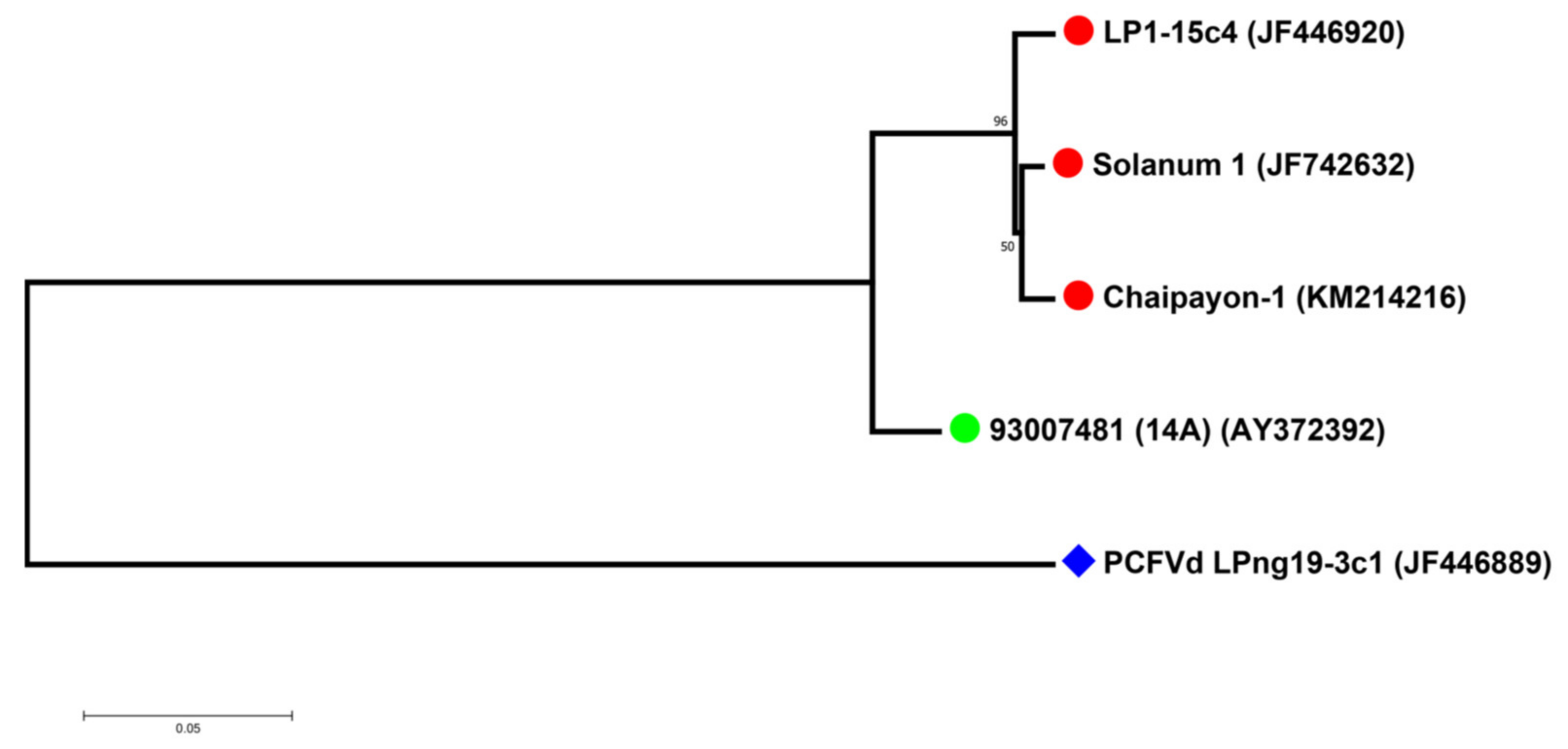
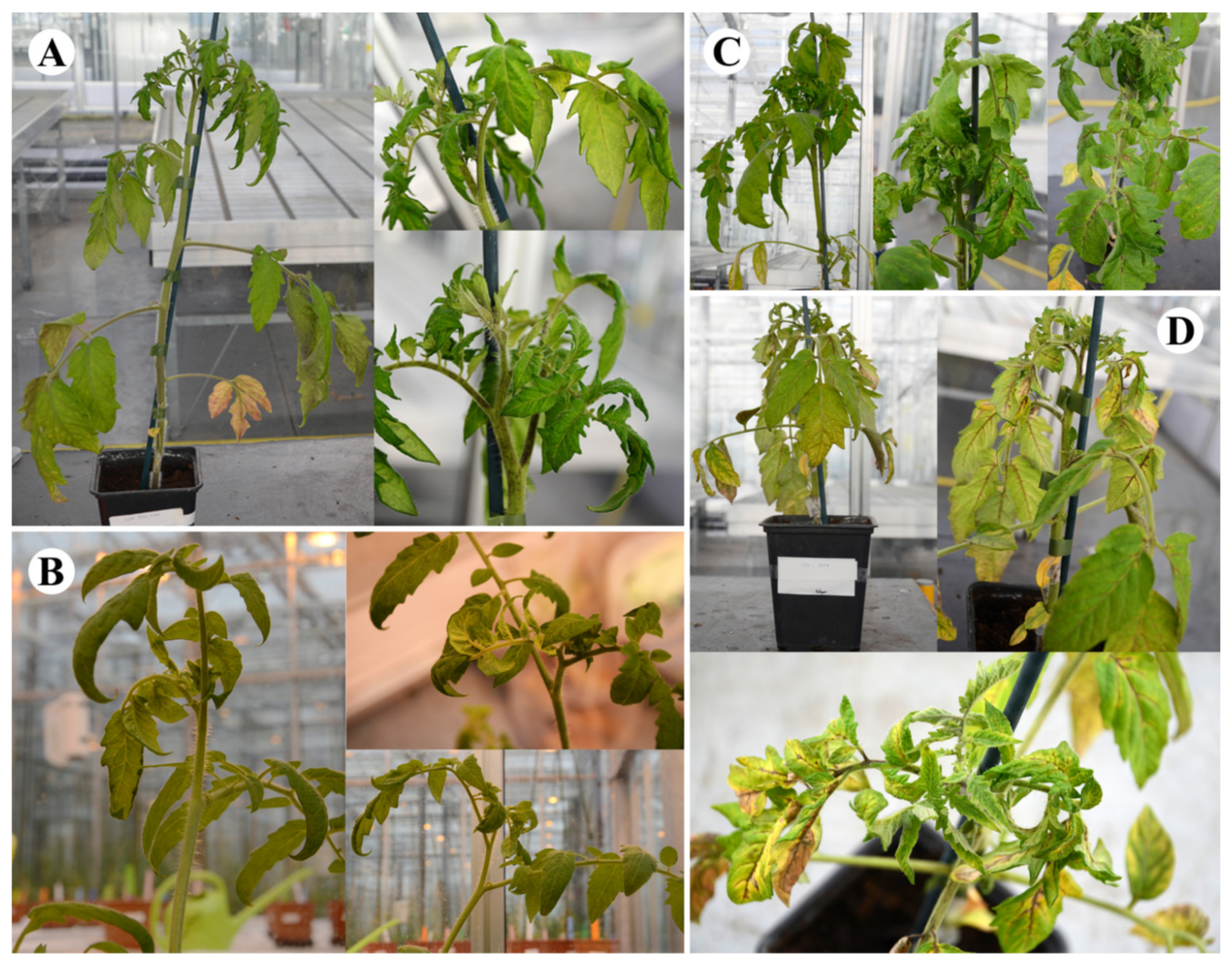
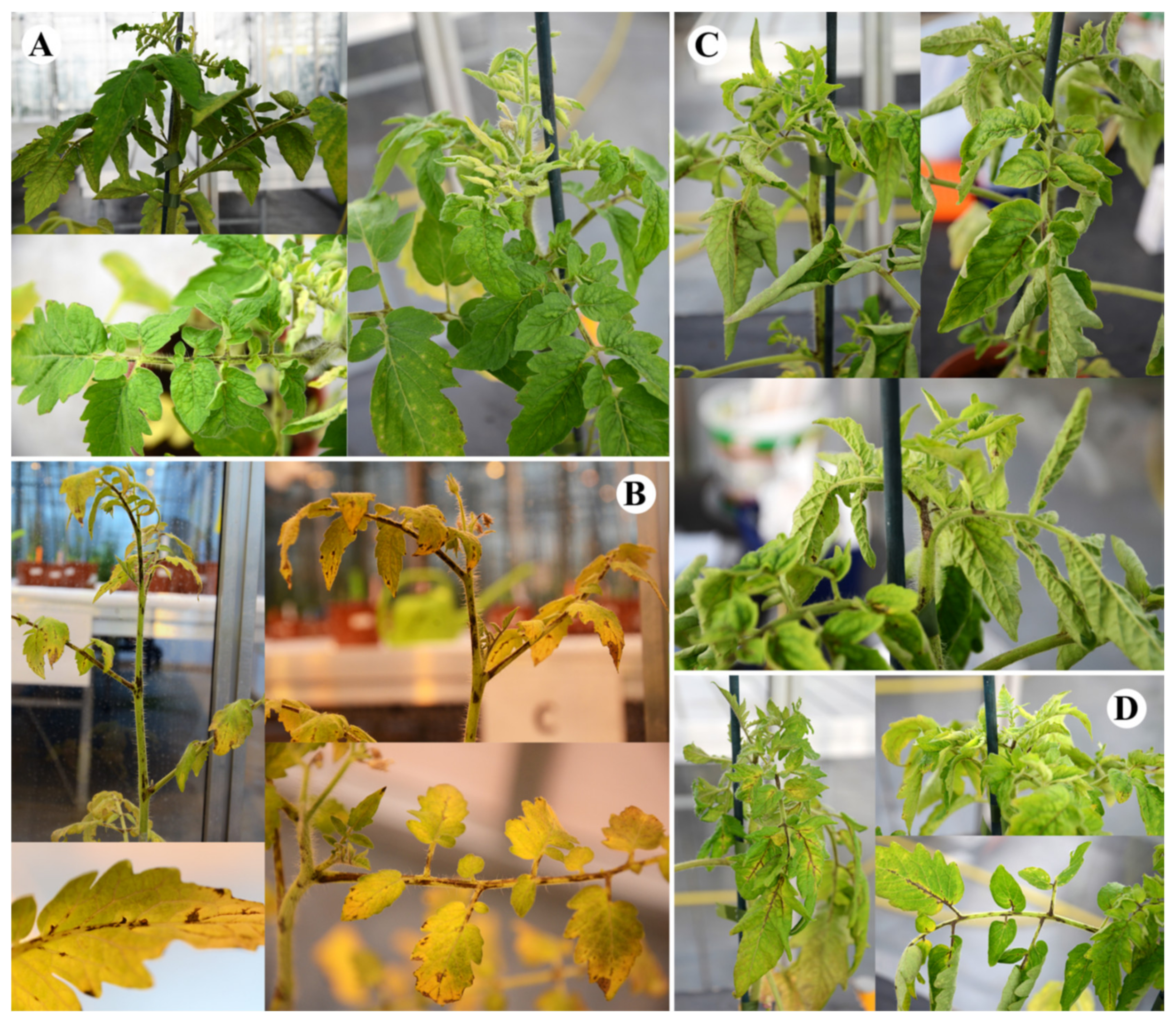

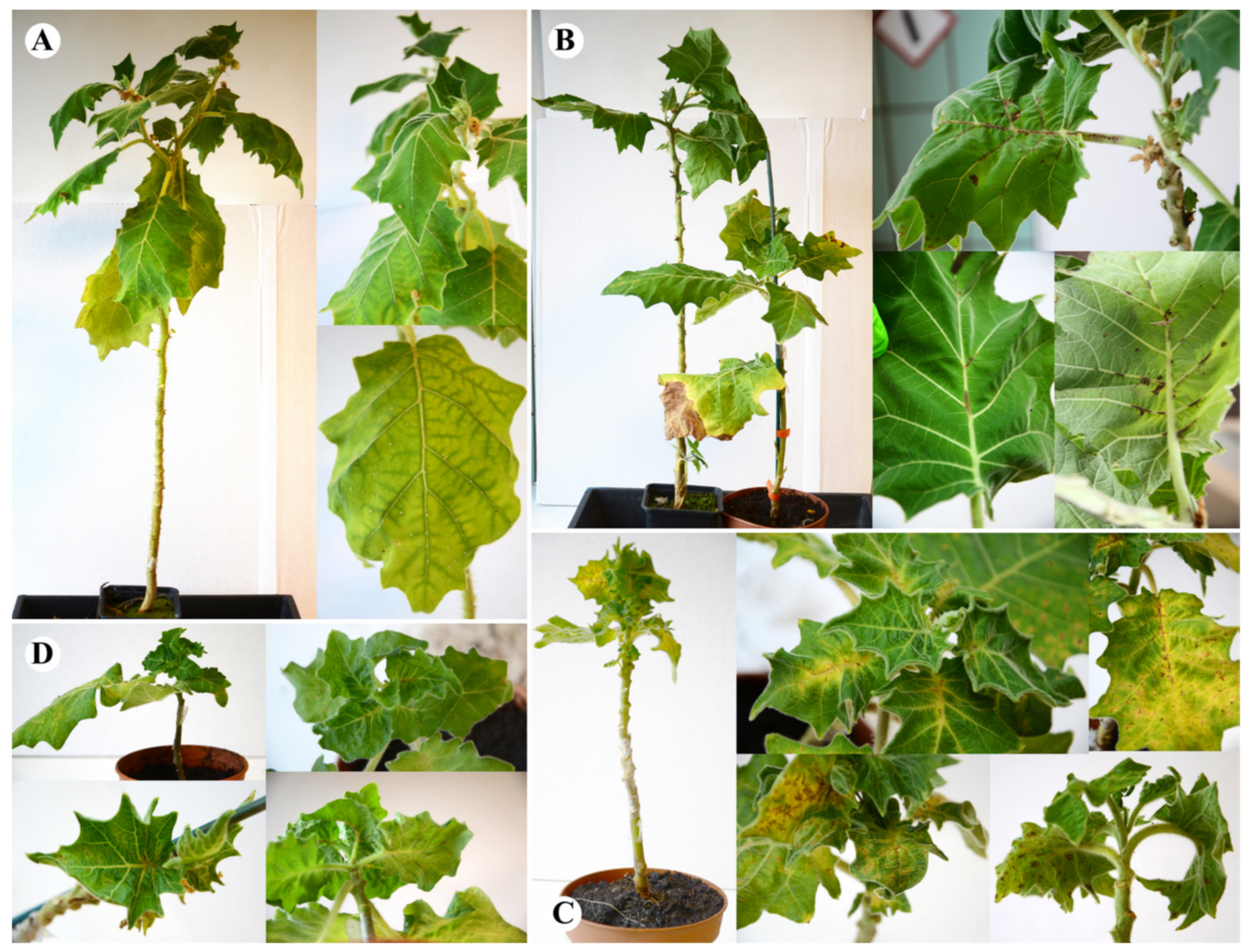
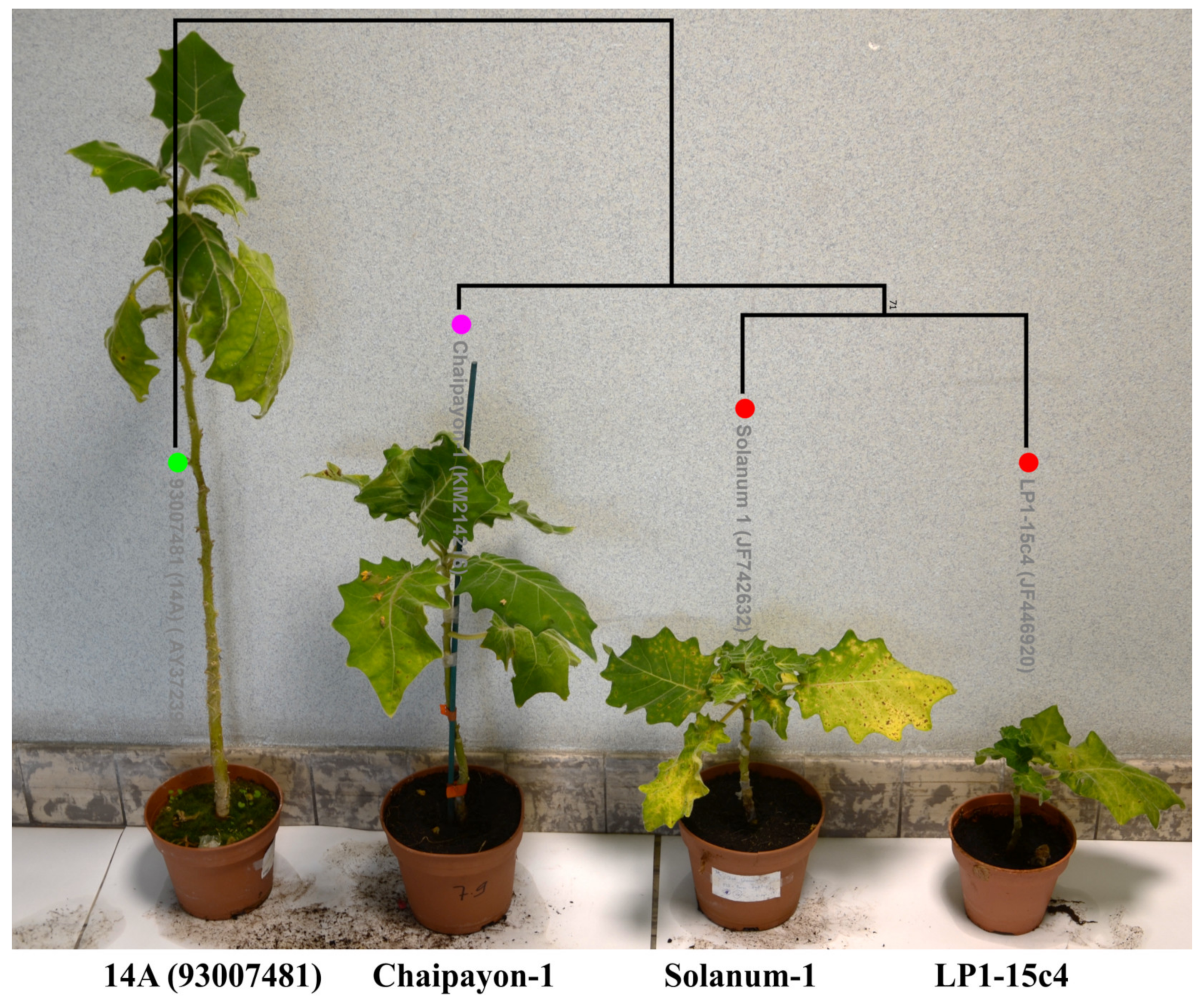
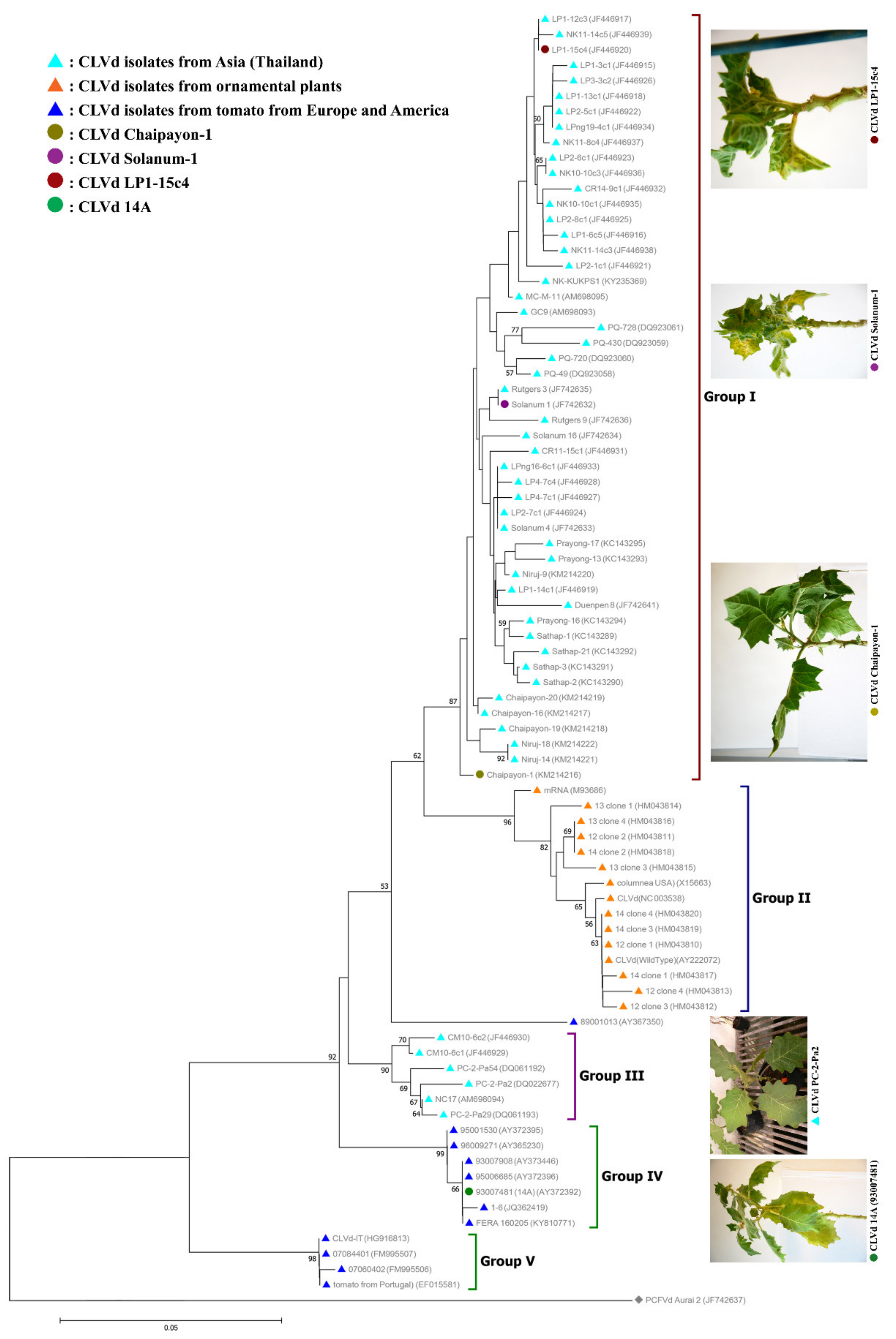
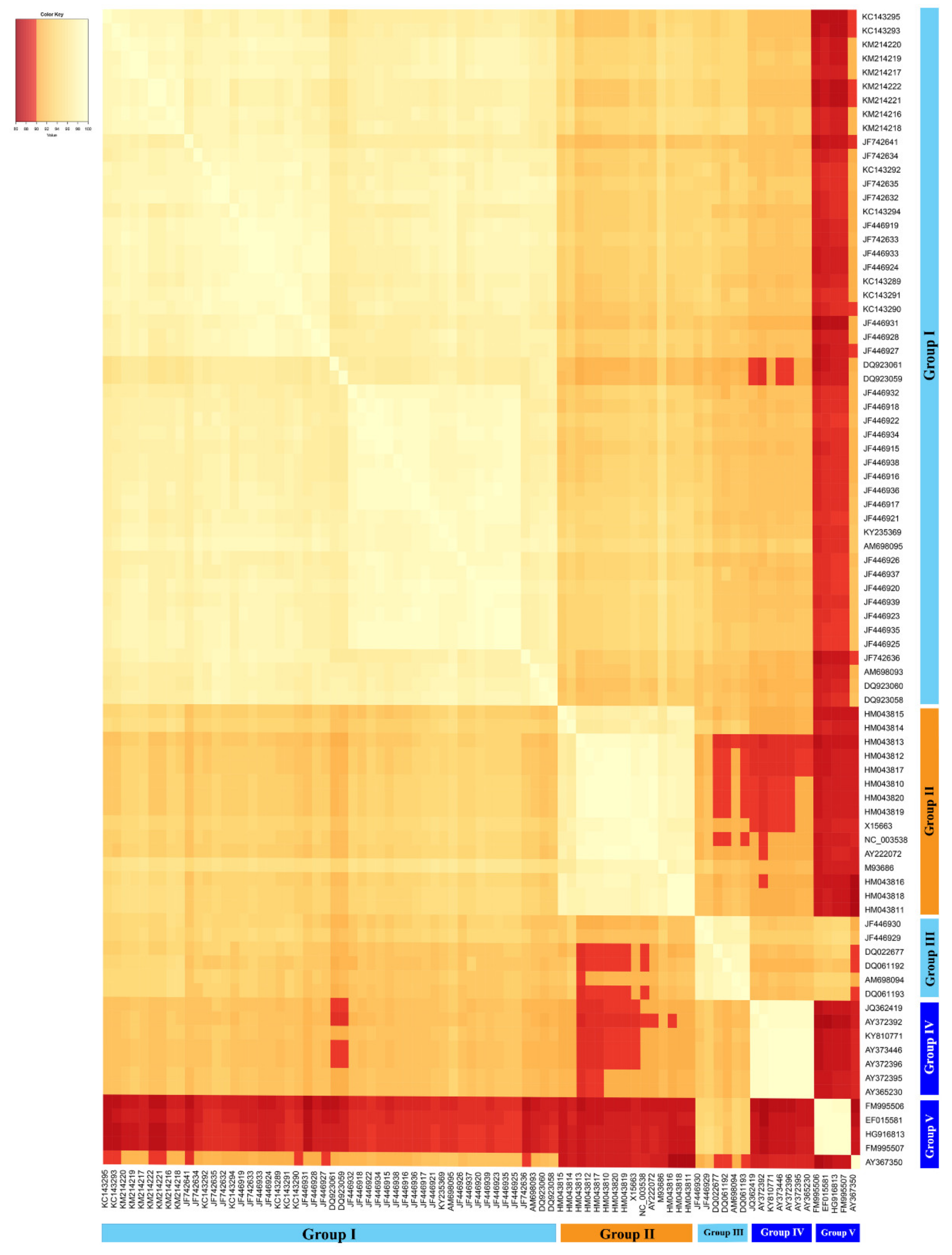
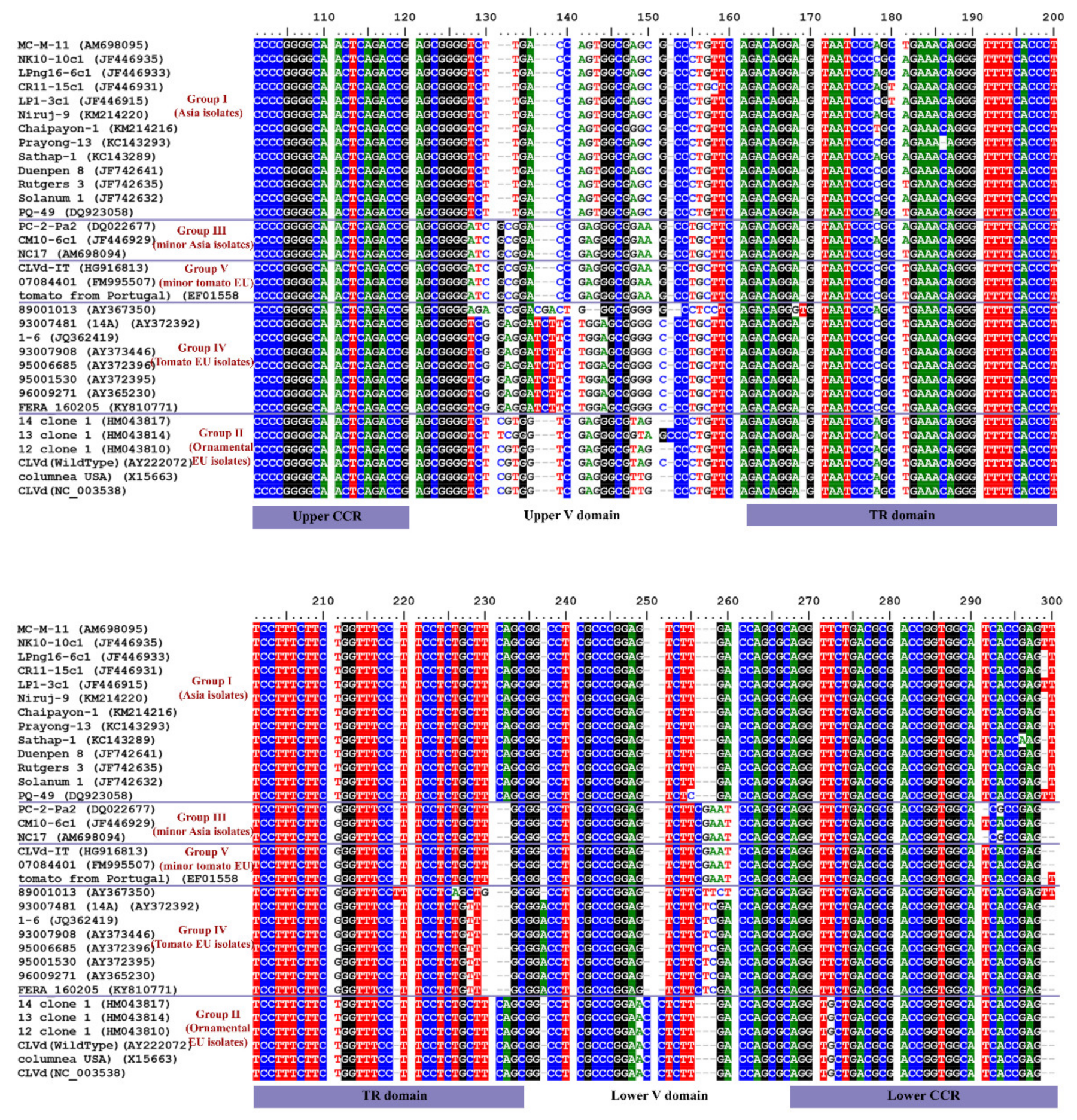
| Isolates | Origin | Type of Inocula | Accession No. |
|---|---|---|---|
| 14A (93007481) | Tomato—The Netherlands | S. stramonifolium (petiole) | AY372392 |
| Chaipayon-1 | Tomato—Thailand | S. stramonifolium (petiole) | KM214216 |
| LP1-15c4 | Tomato—Thailand | S. stramonifolium (petiole) | JF446920 |
| Solanum-1 | Bolo maka—Thailand | S. stramonifolium (petiole) | JF742632 |
| Symptoms | Scale | Weight of Score | Score | Score × Weight | |||||
|---|---|---|---|---|---|---|---|---|---|
| 0 | 1 | 2 | 3 | 4 | 5 | ||||
| Yellowing of Leaves (chlorosis) | no symptoms | yellowing of leaves (chlorosis): mild | yellowing of leaves (chlorosis): moderate | yellowing of leaves (chlorosis): severe | bronzing and/or purpling: mild | bronzing and/or purpling: severe | 10 | ||
| Necrotic Lesions | no symptoms | mild (midrib or vein) | mild (midrib, vein, petiole and stem) | moderate necrotic lesions | severe necrotic lesions | dieback | 40 | ||
| Brittle and Distorted Leaves | no symptoms | leaves are smaller, bunched together | down-curled (mild: only top of the plant) | down-curled (severe: whole plant) | brittle and distorted (mild) | brittle and distorted (severe) | 10 | ||
| Stunted Shoots | no symptoms | Leaves are smaller | bunched together | Internodes are shortened (mild) | Internodes are shortened (severe) | shoots appear stunted overall | 20 | ||
| Stunted Stem | no symptoms | less than 10% reduction | 10%–20% reduction | 20%–30% reduction | 30%–40% reduction | more than 40% reduction | 20 | ||
| Total Score | |||||||||
| Symptoms | Scale | Weight of Score | Score | Score × Weight | |||||
|---|---|---|---|---|---|---|---|---|---|
| 0 | 1 | 2 | 3 | 4 | 5 | ||||
| Distorted Leaves | no symptoms | leaves are smaller | rugosity on leaf margin | mild leaf rugosity and epinasty | severe leaf rugosity and epinasty (top part of the plant) | severe leaf rugosity and epinasty (whole plant) | 30 | ||
| Necrotic Lesions | no symptoms | mild (midrib or vein) | moderate (midrib or vein) | severe (midrib or vein) | necrotic lesions at petiole, stem and other parts (mild) | necrotic lesions at petiole, stem and other parts (severe) | 40 | ||
| Stunted Stem | no symptoms | 10%–20% reduction | 20%–30% reduction | 30%–40% reduction | 40%–50% reduction | more than 50% reduction | 30 | ||
| Total Score | |||||||||
| 14A (93007481) | Chaipayon-1 | LP1-15c4 | Solanum-1 | ||
|---|---|---|---|---|---|
| CLVd isolates | Acc No. | AY372392 | KM214216 | JF446920 | JF742632 |
| 14A (93007481) | AY372392 | 100.00 | 92.82 | 91.18 | 92.03 |
| Chaipayon-1 | KM214216 | 92.82 | 100.00 | 98.36 | 98.64 |
| LP1-15c4 | JF446920 | 91.18 | 98.36 | 100.00 | 98.63 |
| Solanum-1 | JF742632 | 92.03 | 98.64 | 98.63 | 100.00 |
| Symptom Rating Scales | |||||
|---|---|---|---|---|---|
| CLVd Isolates | Tomato | Bolo Maka | Thai Round Eggplant | ||
| Rutgers | Seeda 50 | Insaf | |||
| 14A (93007481) | 3.2 | 2.6 | 1.1 | 0.9 | 0.3 |
| Chaipayon-1 | 4.8 | 3.8 | 2.8 | 3.4 | 0.6 |
| LP1-15c4 | 5.0 | 4.5 | 2.8 | 4.6 | 1.3 |
| Solanum-1 | 5.0 | 4.5 | 2.8 | 4.6 | 1.3 |
| Main Symptoms | |||||||
|---|---|---|---|---|---|---|---|
| CLVd Isolates | Tomatoes | Bolo Maka | Thai Round Eggplant | Chili Pepper and Bell Pepper | Cucumber | ||
| Rutgers | Seeda 50 | Insaf | |||||
| 14A (93007481) | - Moderate necrosis - Mild leaf distortion - Severe stunting | - Severe necrosis (black stripe) - Very mild leaf distortion - Moderate stunting | - Very mild necrosis - Very mild leaf distortion - Very mild stunting | - Very mild leaf distortion - Mild stunting | - Very mild leaf distortion | No symptoms | No infectivity |
| Chaipayon-1 | - Severe necrosis - Severe leaf distortion - Very severe stunting | - Very severe necrosis (black stripe) - Mild leaf distortion - Moderate stunting | - Severe necrosis - Moderate leaf distortion - Very mild stunting | - Severe necrosis - Moderate leaf distortion - Moderate stunting | - Very mild leaf distortion - Very mild stunting | No symptoms | No infectivity |
| LP1-15c4 | - Severe necrosis - Severe leaf distortion - Very severe stunting | - Very severe necrosis (black stripe) - Mild leaf distortion - Severe stunting | - Moderate necrosis - Severe leaf distortion - Very mild stunting | - Severe necrosis - Very severe leaf distortion - Very severe stunting | - Very mild necrosis - Very mild leaf distortion - Very mild stunting | No symptoms | No infectivity |
| Solanum-1 | - Severe necrosis - Severe leaf distortion - Very severe stunting | - Very severe necrosis (black stripe) - Mild leaf distortion - Severe stunting | - Moderate necrosis - Severe leaf distortion - Very mild stunting | - Severe necrosis - Very severe leaf distortion - Very severe stunting | - Very mild necrosis - Very mild leaf distortion - Very mild stunting | No symptoms | No symptoms with 50% infectivity |
Publisher’s Note: MDPI stays neutral with regard to jurisdictional claims in published maps and institutional affiliations. |
© 2021 by the authors. Licensee MDPI, Basel, Switzerland. This article is an open access article distributed under the terms and conditions of the Creative Commons Attribution (CC BY) license (https://creativecommons.org/licenses/by/4.0/).
Share and Cite
Tangkanchanapas, P.; Haegeman, A.; Höfte, M.; De Jonghe, K. Reassessment of the Columnea latent viroid (CLVd) Taxonomic Classification. Microorganisms 2021, 9, 1117. https://doi.org/10.3390/microorganisms9061117
Tangkanchanapas P, Haegeman A, Höfte M, De Jonghe K. Reassessment of the Columnea latent viroid (CLVd) Taxonomic Classification. Microorganisms. 2021; 9(6):1117. https://doi.org/10.3390/microorganisms9061117
Chicago/Turabian StyleTangkanchanapas, Parichate, Annelies Haegeman, Monica Höfte, and Kris De Jonghe. 2021. "Reassessment of the Columnea latent viroid (CLVd) Taxonomic Classification" Microorganisms 9, no. 6: 1117. https://doi.org/10.3390/microorganisms9061117
APA StyleTangkanchanapas, P., Haegeman, A., Höfte, M., & De Jonghe, K. (2021). Reassessment of the Columnea latent viroid (CLVd) Taxonomic Classification. Microorganisms, 9(6), 1117. https://doi.org/10.3390/microorganisms9061117







